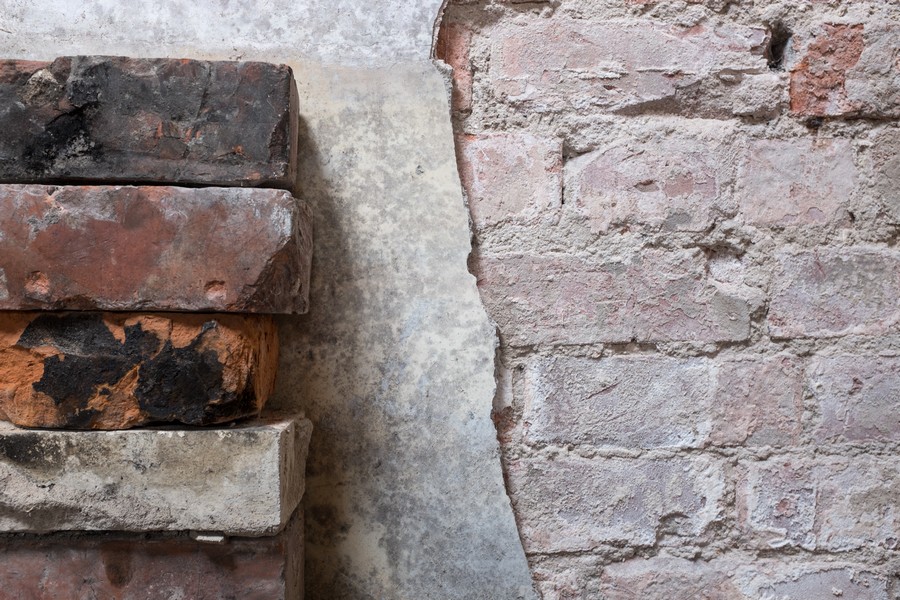Contact Sussex Damp Experts Now to Speak With an Expert.

Damp affects support structures such as walls, floors, ceilings and roofs, and all the wood elements. If the damp is not controlled and eliminated, the property’s structure elements will begin to decay, jeopardising the support structure and resulting in more significant issues.
It’s always better to avoid addressing a problem because the solution is usually more complicated (and expensive) than the efforts taken to prevent it. However, sometimes it’s too late by the time it’s identified, and treatment, repairs, and replacements are the only options.
Damp signs showing on walls can indicate that the damp proof course has been compromised or that the exterior coating no longer resists rain penetration. Sussex Damp Experts have addressed and helped solve lots of rising damp problems with treatments, repairs and prevention procedures to achieve damp proofing buildings that provide comfortable inside living. If you are concerned about any damp problem in a property, please get in touch with our knowledgeable staff at 01273 257 765 for assistance.
Rising damp is when water from the ground seeps into a building through the pores in the brickwork, a process known as capillary action. When gravity and evaporation obstruct the capillary action’s pull, rising damp will halt, leaving a noticeable “tide-mark” roughly 1m high. However, other symptoms of rising damp may be evident above 1m due to non-porous renders or wall paint. Porous materials such as plaster, lumber, and wallpaper are commonly used to surround walls. A lot of visual damage occurs as these materials decay and disintegrate.
Salts in groundwater flow up through the bricks and leave white stains on the internal wall, which is another common symptom of rising moisture.

It is common to confuse rising damp with other types of dampness, so it is critical to hire a damp specialist to correctly determine the kind of damp in the building. One widespread misunderstanding is that if you see a tide mark on your wall, it means you have a rising damp problem.
External faults, such as poor guttering or overgrown vegetation in the gutters, are sometimes linked to indicators of penetrating damp rather than rising damp.
It’s also worth noting that your property may not have had an efficient damp proof course installed in the last 20 years. If you notice mould on your walls, this could be a symptom of humidity caused by condensation. Rising damp differs from other types of damp in that it cannot exist above the first level because moisture rises from the soil onto the property’s walls.
There are a number of key rising damp signs that you may have seen in your home that indicate you have a rising damp problem. This website will assist you in gaining a better understanding of the most common rising damp indications. Additionally, this article will assist you in understanding the sources of these indications in your home. Even if you believe your house is suffering from rising damp after reading our list of important rising damp indications, it is still a good idea to get our professional examination of the area to be sure.
It’s critical to get the correct diagnosis for the rising damp problem so that it can be resolved as quickly as possible. Sussex Damp Experts’ professional surveyors can conduct a thorough damp survey of the property and accurately diagnose the leading cause of the problem. Rising damp can be difficult to distinguish from other types of damp, such as condensation or penetrating damp, to the untrained eye. Sussex Damp Experts can help you with that by calling 01273 257 765 to get one of our specialists to check the property.
Contact Sussex Damp Experts Now to Speak With an Expert.
There are numerous telltale symptoms that your home is suffering from a rising damp problem that can be recognised by property users. Knowing how to recognise rising damp might assist you in quickly resolving the rising damp issue.
Tide marks on walls are one of the most common symptoms of growing wetness. Tide markings are created by wet evaporation and salt migration from the ground that has made its way up the wall. These can be seen from the bottom of the wall to about a metre above the ground. If you can’t see tidemarks, search for damp stains or patches on your walls as an alternative. These patches are brown or dark yellow in colour, and they can be found from the bottom of the wall to one metre above the floor, just like tidemarks.
If the damp is visibly higher than one metre up the wall, it could still result from rising damp, but it is more likely that your home has a penetrating damp problem. Penetrating damp may be present in addition to rising damp, necessitating caution in determining the accurate diagnosis.
If your home has damp or moist patches on the walls, rising damp is likely to be the source. This is caused by capillary action, which causes moisture from the ground at the base of your property walls to rise through the brick or stonework. This could be rising damp if the damp patches are only on the lower wall section and the home is on the ground floor. If there isn’t an efficient Damp Proof Course at the bottom of the wall, rising damp will affect it. The only floor of a house where rising dampness can develop is the ground floor.
If you have a damp problem on a floor higher than the ground floor, it is likely to be a different type of damp problem (most likely penetrating damp or condensation).
The unmistakable smell of damp within the property is one of the most straightforward damp indications to identify. Even if you can’t see wet in your home, you can almost always smell it. The damp has a particular odour that is frequently described as unpleasant, musky, and moist. However, if there is no visible indication of wet on the property fabric, diagnosing the sort of damp that is damaging the property may be challenging, and you may need the assistance of a Specialist Damp Surveyor. Different types of damp require other treatments. Therefore it’s critical to get your damp problem identified correctly to fix it as quickly as possible.
The presence of black mould in the bottom areas of your wall is a clear indication that the area is moist. If black mould is present, it indicates that you have a condensation problem; however, if the problem arises on the lower half of the ground floor walls, it could suggest rising or penetrating dampness, which would need to be addressed.
Moisture travels upwards through the stonework thanks to capillary action. As moisture rises up the wall structure from the ground, it picks up salts from the earth, which migrate into the property and harm the plaster and decoration. These salts are known as hygroscopic salts, which means they draw moisture from the air and will cause your wall to become damp. When you touch the walls, they may feel damp. The salts are brought to the surface as the moisture in the wall evaporates, and the salts can occasionally be visible as a white coating on the surface.
If your damp wall is caused by rising damp, it will also be affected by damp generated by hygroscopic salts, which must be addressed as part of the rising damp problem remediation.
Peeling wallpaper or paint is another common symptom of rising humidity. As a result of the ongoing damp difficulties, the amount of moisture within your walls will rise. More moisture on the wall might cause wallpaper or paint to peel away. This is especially noticeable along with the skirting board or along the lowest portion of the wall. In these situations, the wallpaper will usually come free initially immediately above the skirting board, with the edges curling away from the wall.
On the other hand, peeling wallpaper or paint could indicate a condensation or penetrating damp problem in the house, necessitating an accurate diagnosis to guarantee that the suitable repair specification is implemented to fix the problem.
If you notice flaking or bubbling plaster, crumbling plaster, or powdery deposits on your walls on the ground floor, it’s a sign that you have a damp problem, which could be rising damp. The moisture from rising humidity can cause plaster on walls to degrade and crumble to the point where it falls off the wall. This might result in noticeable cosmetic damage to your house’s ornamented and plastered walls, which can be highly costly for property owners if not addressed as soon as feasible.
Skirting boards and floors may begin to decay if the increasing damp problem in your home is left ignored for an extended time. This is due to excessive moisture damaging the timbers, which allows a fungal attack to germinate. Like many other types of damp, rising damp can cause rot in the timbers it comes into direct touch with. Skirtings and other timbers that show symptoms of cracking or that disintegrate quickly when touched should be avoided by property owners. Where the home has been harmed by long-term wetness, visible fungus growing on the skirting boards or flooring timbers may be visible.
Unprotected iron and steel will rust if exposed to excessive moisture levels for an extended period of time. The property might become significantly less secure because rust causes iron and steel fasteners to lose their stability. Fasteners such as cavity wall ties in the property rusting and no longer functional can significantly impact the property’s structural integrity.
The internal and external surfaces of ground-floor walls can be severely harmed by rising damp. Repairing crumbling bricks and mortar can be pricey. Rising damp can produce loose or crumbling bricks or mortar, which can become exceedingly porous and allow penetrating damp to penetrate the masonry, causing further damage to internal walls. Fortunately, decaying bricks or mortar may be easily identified, and the condition is commonly referred to as fretting. Check the cement joints on your external brickwork or stonework when checking it.
If you observe any cracking or powdery mortar or deterioration of the brick surface, your brickwork is fretting due to moisture and salt deposits. Mortar may be almost entirely gone from the joints in the later phases.
Call Our Sussex Damp Experts team now for quote, consultation and advice:
Call on 01273 257 765.
Our experienced damp surveyor will conduct a complete damp survey of the afflicted area before beginning any rising damp treatment. This enables them to accurately diagnose the sort of damp problem your house is experiencing and then define the necessary repairs to address the issue. Our expert technicians will do the repairs in a timely and cost-effective manner. The type of rising damp remedial work required is determined by the type of property and its current state. This may necessitate the removal of wall fabric, the repair of an existing DPC, or the installation of a new DPC.
If the old damp proofing system fails, our experts will install a brand new damp proofing system. A chemical DPC is frequently the most cost-effective solution to a developing damp problem. This technology aims to create a continuous layer of waterproof material that serves as a barrier, preventing moisture from the ground from rising up the masonry walls. This method usually entails drilling small holes in the wall to enable the installation of new DPC material, which is fed into the holes to protect the walls from increasing damp. All plasterwork that has been hygroscopic salts and rising damp must be stripped.
To avoid salt migration and allow the wall plaster to dry faster, a cavity wall damp proof membrane may be put prior to re-plastering. This is to guarantee that any sections of the plaster that have been affected by salt have been removed. The wall can then be coated with renovating plaster to prevent further salt migration when the new DPC is installed.
Don’t be concerned if you’re feeling frightened by all of this. Our experts have been providing damp property solutions to commercial and private properties around Sussex with 20 years of combined experience within the team. For your peace of mind, we will be able to diagnose your property’s damp problem, determine the most appropriate and cost-effective solution for your property’s specific damp problem, and provide you with a long-term guarantee on the remedial work.



Sussex Damp Experts has a wide choice of goods and brands to choose from. Each instance has its own set of requirements and limits, resulting in a wide range of rot damage treatment and repair alternatives.
As soon as any of the symptoms listed above arise, a specialist should treat rising damp. The longer it goes untreated, the worse it will get and the greater the damage to the house’s structure.
Please contact our staff at 01273 257 765 to schedule a survey because no two cases are the same. One of our surveyors will visit your home to discuss your concerns and requirements to provide the most cost-effective quote to give you peace of mind.
Sussex Damp Experts are damp proofing experts who can assist you with everything from inspections to treatments and repairs for wood, walls, ceilings, and floors. Commercial property owners, property management businesses, and residential property owners are among our clientele.
Our rot treatment specialists will inspect and evaluate the severity of the damp problem in your property. Specific damp and timber treatments and rotten timber repairs are among our specialities, and we use the most effective methods to fix the problem.
Our employees have completed training that meets or exceeds the requirements of the industry. Our surveyors are all Certified Surveyors in Remedial Treatment (CSRT), ensuring the highest level of service to our customers.
The following are some of the benefits of using our services:
Call us at 01273 257 765 or email us if you are experiencing any damp problems at a property.


Max and his team have been at our property all week and I really can’t thank them enough for the fantastic job they’ve done on plastering both our walls and ceilings. They have literally transformed the appearance of our house! Not only has Ma…

From start to finish Max has been incredable. His knowledge lin damp proofing is second to none and his team where very clean and polite. The plastered finish was like glass so happy we choose Max Plastering for job.

Lovely bunch of lads left a very neat and clean job. Problem was solved.

Perfect Finnish and all left clean and tidy and no mess. Used Max previously and would not hesitate to ask him carry out more work.

Max, Harvey and Stuart arrived promptly as arranged. Done a great job on our outside rear wall. Work completed to a high standard, removal of all old material and cleaned up after themselves. I am so pleased with the standard of their work they ar…

They turned up on time and carried out the works in a very professional manor leaving the front of the house clean and tidy. Very impressed would definitely recommend.

I have to say that on every level Max (with Stuart and Harvey) did an extremely professional job! They explained what they were going to do, they were polite and courteous and respected that they were coming into our home. The plastering is of the…

I called max and he managed to come around the same day to do a survey. The next day I received an extremely detailed survey compared to any other damp proofer which made me feel very at ease that he was going to do the right job. Max and team tur…

Contact Sussex Damp Experts Now to Speak With an Expert.